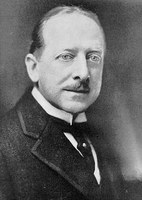 | Back to e-WV
| Back to e-WV
 The West Virginia Encyclopedia
The West Virginia Encyclopedia
 | Back to e-WV
| Back to e-WV
 The West Virginia Encyclopedia
The West Virginia Encyclopedia

Edward Bates Franzheim (July 20, 1866-May 11, 1942) was one of West Virginia’s major architects and among the first to receive formal, academic training in his profession. Youngest son of a prominent Wheeling family, he attended classes at Chauncy Hall, a preparatory school for the Massachusetts Institute of Technology, then apprenticed with Boston architect John H. Sturgis. He subsequently studied abroad before returning to Wheeling in 1890.
Vance Memorial Presbyterian Church (1896), one of West Virginia’s most exuberant Richardsonian Romanesque buildings, reflects his Boston training and demonstrates his mastery of the style. By 1902, Franzheim was probably the most successful architect in the state. That year he designed the Board of Trade-Court Theatre, a multi-purpose commercial structure in downtown Wheeling, and began a second career. For five years he managed the theater, took leading roles in its productions, and authored plays. Architecture remained his first love, however, as evidenced by his lavish domestic designs, in many different styles, for Wheeling’s business and professional leaders. Franzheim was responsible for major alterations to Oglebay Mansion and the Fort Henry Club, and designed houses for prominent oil magnates in Sistersville.
Known as a ‘‘bon vivant,’’ Franzheim carried a yellow cane and gloves, wore spats in season, and habitually arrived at the office in morning clothes, but changed to a black jacket in the afternoon. Franzheim’s many surviving works testify to his talent.
Written by S. Allen Chambers Jr.